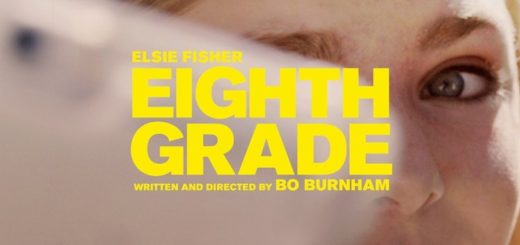THE DEVIL’S CANDY Review
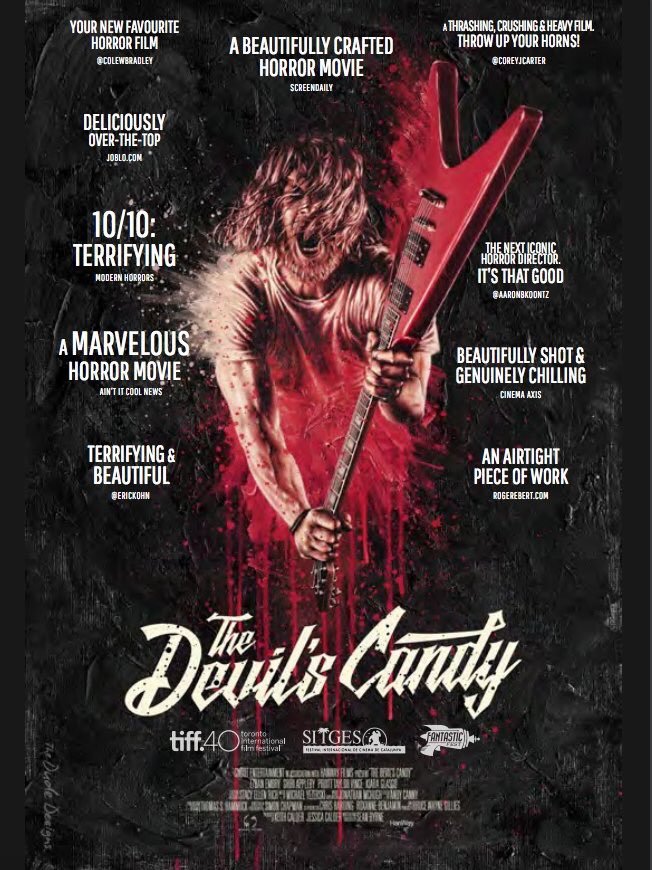
Director: Sean Byrne
Genre: Drama, Horror
Year: 2017
Satan is boring. There, you heard me said it. Despite naturally lending himself to the horror genre, Ol’ Beelzebub has historically proven to be a fairly impotent antagonist. The fear to be found in Satan, if there is any, is the fact that he’s a force of ancient, mystical evil, with a scope of power and ill will that’s almost impossible to accurately portray, akin to Cthulhu and company. Since almost any attempted mediation will inevitably end in disappointment, we’ve almost entirely been treated to interpretations of him that end up consisting of suave, menacing men in well-tailored suits. The biggest takeaway from THE DEVIL’S CANDY is that instead of offering yet another tepid cinematic portrayal of Mr. Morningstar, Sean Byrne’s second time around the filmmaking merry-go-round instead focuses on the question of whether he’s present in and responsible for the narrative at all. The film plays with just enough tropes that it manages to propel itself to its end, but it’s ultimately an uneven outing nonetheless.
THE DEVIL’S CANDY focuses on the unfortunately named Hellman family: Jesse (Ethan Embry), a metal fanatic, painter, and possessor of washboard abs, Astrid (Shiri Appleby), the almost entirely ignored mother, and Zooey (Kiara Glasco), a daughter who dotes on and wants to emulate her Cool Metal Daddy™. Having just moved to Austin, Texas, most of the Hellman family is excited to find a country home being sold for a song, with only Astrid getting cold feet once it comes about that Ray Smile (Pruitt Taylor Vince), the murderous son of the previous owners, is on the loose, still plagued by the demonic voices that he insists encourage him to kill children for the devil. Before we know it, Jesse is also experiencing something presumably Satanic, blacking out for periods of time and painting a horrifying portrait of Zooey being chased by denizens of the underworld. Topped off with Ray becoming interested in adding Zooey to his body count, the Hellmans soon find themselves in a struggle for survival.
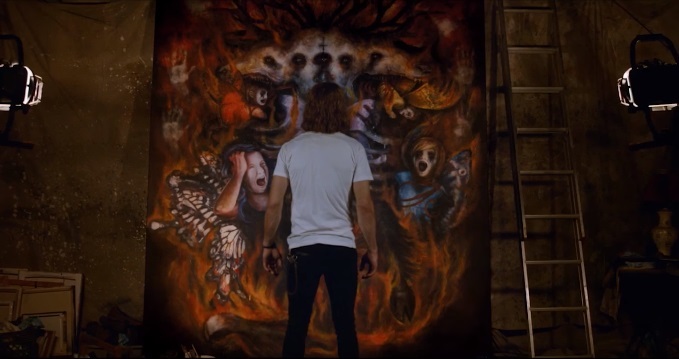
Talk about The Morning After…
I will admit, in terms of my subjective tastes, the film has two large cards stacked against it. First and foremost, this is decidedly more on the thriller side of the horror spectrum. Despite the hotbed of horror potential that a Satanic premise cultivates, the scares of THE DEVIL’S CANDY are all to be found in the decidedly terrestrial. While the painting that Jesse is unconsciously creating is certainly unsettling, there’s only so many times we can be shown it before it begins to lose its bite. In particular, there’s a scene towards the end where portions of the painting slowly peel away, and the disappointment that occurred when nothing more explicitly sinister failed to appear in its stead was palpable. With Satan mostly leaving Ray to handle the scares in his stead, we’re dropped into several definitive scenes of home invasion-based tension, but nothing unduly creepy-crawly apart from a moment where Ray breaks into the Hellman house and cuddles up next to Zooey in her bed.
In addition, the film is yet another entry in the neverending canon of horror films that end up making metal seem as sopohomoric as many people perceive it as. While not quite misstepping as hard as GREEN ROOM in terms of representation of a subculture, we’re once again presented with a middle-aged mother’s understanding of the symbols and icons of the world’s most misunderstood genre. While it makes some sense for Zooey to rotely worship Metallica, Slayer, and Flying V guitars, considering that she’s a young fan of the genre, if we’re to believe that Jesse loves the music for more than its surface-level aesthetics and has followed it his whole life, then it would be nice to see him represent deeper cuts than anyone with access to Wikipedia can find within minutes after searching “metal.” Since this is as much as a “metal film” as it is a “horror” one, it’s unfortunate that a true lover of the genre wasn’t at the helm, willing to showcase the depth and breadth of the artistry present instead of another tepid offering of devil horns, goats, and distorted guitar.
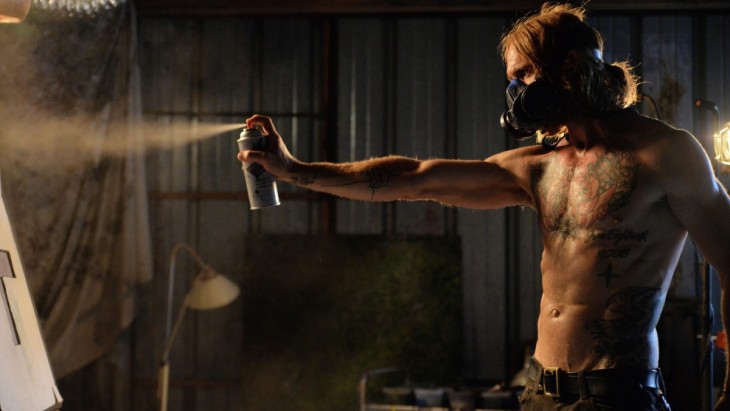
This is the most metal image in the movie, and it involves a can of spray paint
All that aside, Byrne’s feature still manages to be, at worst, mildly enjoyable thanks to a surprisingly strong thematic core of parental anxiety. Whereas most of the film’s peers elect to put their eggs in the basket of visual titillation, THE DEVIL’S CANDY is driven forward by Jesse and Zooey’s relationship. It’s one of the strongest marks against the character writing that Astrid is relegated to the role of a shrewish and square henpecker, continually trying to harsh Jesse and Zooey’s buzz, man, but the film mostly makes up for it with its evocative portrayal of a young father coming to terms with more involved parenting as his daughter grows older. The empathy we feel for Jesse is rooted in the fact that he has a passionate, genuine interest in his daughter as a person, often coming across as a brother or friend as opposed to a father. While Jesse ends up feeling obligated to physically protect and defend her, he never speaks down to Zooey or treats her as something to be sheltered or regulated, offering us the rare chance to see a young, female character treated with compassion and respect; this serves double duty, as we can fully and effectively feel Zooey’s pain as Jesse becomes more and more self-absorbed and preoccupied with his possibly supernatural painting, eventually leaving his daughter in direct danger due to his own negligence.
On the topic of the danger the Hellmans find themselves in, Pruitt Taylor Vince deserves most of the credit for the moments of tension present within THE DEVIL’S CANDY. An equally childish and menacing presence, Byrne spent enough time in the writing room to give us an antagonist we fear as much as we fear for with Ray Smile. Constantly hounded by evil incantations that only he can hear, while it would have been fun to have seen the subplot involving Ray being able to keep them at bay by playing metal guitar riffs more fully developed, the shots of him coldly butchering children and kidnapping Zooey juxtapose nicely with the ones where he pathetically eats candy and cries in regret and desperation. As briefly mentioned above, the star moment of the film occurs when Ray climbs into bed with Zooey, uninvited. Demonstrating a clear platonic affection for her while simultaneously forcefully keeping a hand over her mouth, Ray proves himself an unwilling participant in Satanic schemes of child sacrifice, but one that steadfastly upholds his obligation to his master all the same.
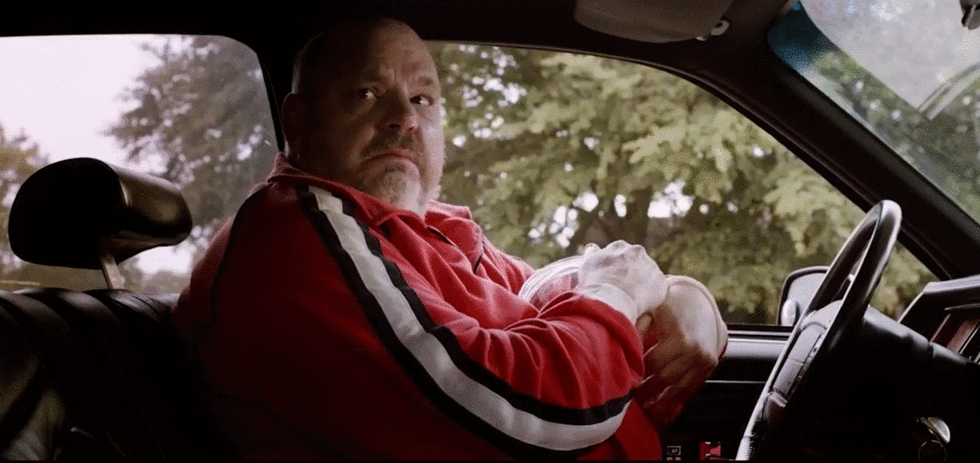
Simply THE Stranger with Candy
The big “punchline” of the film is that it’s likely that there was never anything untoward going on after all, at least in terms of whether or not Satan is real and active. And yet, this is where the plot holes being to reveal themselves. While Ray’s narrative is the meat and potatoes of the film and is appropriately concluded, the subplot involving Jesse and the painting is undercooked and ultimately rather confusing. Byrne seems very satisfied that he has Jesse attempt to sell his painting to Belial, a sinister looking art collector whose assistant dresses in all red clothing and makeup, only for these obviously devilish signifiers to not culminate in anything demonic, but we’re never offered enough closure for this to feel like a confident authorial choice. If anything, it just feels hastily construed and lazily abandoned, with there never being enough tension in Jesse’s painting subplot to even come close to the story elements related to Zooey’s safety. There’s a version of this story that makes a stronger statement about how our minds are primed to experience something because we’re in a situation where other people did the same (ie. Jesse becoming possessed after hearing that Ray was), but it’s not the one we’re presented with here.
I feel somewhat guilty, as it truly isn’t a bad little evening view, but THE DEVIL’S CANDY is a bit too lukewarm to get excited about. Considering the blistering debut Byrne experienced with THE LOVED ONES, his follow-up feels strangely uninspired. I appreciate what he does structurally with a devil narrative, but there’s too much here that’s simply not scary to succeed as a horror film. The character writing is stronger than I expected, and there are moments where Ray shines bright enough to fully grasp the attention, but I’d put quite a few more movies ahead of this one in any Netflix queue. And yes, I am also being a little pissy about the metal.
Verdict: Do Not Recommend

